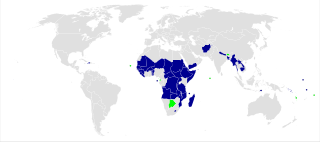Related Research Articles

Gross domestic product (GDP) is a monetary measure of the market value of all the final goods and services produced in a period of time, often annually. GDP (nominal) per capita does not, however, reflect differences in the cost of living and the inflation rates of the countries; therefore using a basis of GDP per capita at purchasing power parity (PPP) is arguably more useful when comparing differences in living standards between nations.

The Economic Community of West African States, also known as ECOWAS, is a regional economic union of fifteen countries located in West Africa. Collectively, these countries comprise an area of 5,114,162 km2 (1,974,589 sq mi), and in 2015 had an estimated population of over 349 million.
An economic indicator is a statistic about an economic activity. Economic indicators allow analysis of economic performance and predictions of future performance. One application of economic indicators is the study of business cycles. Economic indicators include various indices, earnings reports, and economic summaries: for example, the unemployment rate, quits rate, housing starts, consumer price index, consumer leverage ratio, industrial production, bankruptcies, gross domestic product, broadband internet penetration, retail sales, stock market prices, and money supply changes.

The Least Developed Countries (LDCs) is a list of developing countries that, according to the United Nations, exhibit the lowest indicators of socioeconomic development, with the lowest Human Development Index ratings of all countries in the world. The concept of LDCs originated in the late 1960s and the first group of LDCs was listed by the UN in its resolution 2768 (XXVI) of 18 November 1971.
The green gross domestic product is an index of economic growth with the environmental consequences of that growth factored into a country's conventional GDP. Green GDP monetizes the loss of biodiversity, and accounts for costs caused by climate change. Some environmental experts prefer physical indicators, which may be aggregated to indices such as the "Sustainable Development Index".

The Index of Sustainable Economic Welfare (ISEW) is an economic indicator intended to replace the Gross Domestic Product, which is the main macroeconomic indicator of System of National Accounts (SNA). Rather than simply adding together all expenditures like the gross domestic product, consumer expenditure is balanced by such factors as income distribution and cost associated with pollution and other unsustainable costs. It is similar to the Genuine Progress Indicator (GPI).

Gross National Happiness is a philosophy that guides the government of Bhutan. It includes an index which is used to measure the collective happiness and well-being of a population. Gross National Happiness is instituted as the goal of the government of Bhutan in the Constitution of Bhutan, enacted on 18 July 2008.
The National Center for Education Statistics (NCES) is the part of the United States Department of Education's Institute of Education Sciences (IES) that collects, analyzes, and publishes statistics on education and public school district finance information in the United States. It also conducts international comparisons of education statistics and provides leadership in developing and promoting the use of standardized terminology and definitions for the collection of those statistics. NCES is a principal agency of the U.S. Federal Statistical System.

The Fragile States Index is an annual report published by the United States think tank the Fund for Peace and the American magazine Foreign Policy since 2005. The list aims to assess states' vulnerability to conflict or collapse, ranking all sovereign states with membership in the United Nations where there is enough data available for analysis. Taiwan, the Palestinian Territories, Northern Cyprus, Kosovo and Western Sahara are not ranked, despite being recognised as sovereign by one or more other nations. Ranking is based on the sum of scores for 12 indicators. Each indicator is scored on a scale of 0 to 10, with 0 being the lowest intensity and 10 being the highest intensity, creating a scale spanning 0−120.
Global Integrity is an independent, nonprofit organization tracking governance and corruption trends around the world using local teams of researchers and journalists to monitor openness and accountability. Global Integrity's reporting has been cited by over 50 newspapers worldwide, and is used by the World Bank, USAID, Millennium Challenge Corporation and other donor agencies to evaluate aid priorities. Global Integrity's methodology differs considerably from existing metrics of governance and corruption by using local experts and transparent source data, rather than perception surveys. Unlike traditional charities, Global Integrity is a hybrid organization that seeks to generate earned revenue to support its public-interest mission.
Sustainable metrics and indices are measures of sustainability, and attempt to quantify beyond the generic concept. Though there are disagreements among those from different disciplines, these disciplines and international organizations have each offered measures or indicators of how to measure the concept.

This article includes a list of China's historical gross domestic product (GDP) values, the market value of all final goods and services produced by a nation in a given year. The GDP dollar estimates presented here are either calculated at market or government official exchange rates (nominal), or derived from purchasing power parity (PPP) calculations. This article also includes historical GDP growth.
System of Environmental-Economic Accounting (SEEA) is a framework to compile statistics linking environmental statistics to economic statistics. SEEA is described as a satellite system to the United Nations System of National Accounts (SNA). This means that the definitions, guidelines and practical approaches of the SNA are applied to the SEEA. This system enables environmental statistics to be compared to economic statistics as the system boundaries are the same after some processing of the input statistics. By analysing statistics on the economy and the environment at the same time it is possible to show different patterns of sustainability for production and consumption. It can also show the economic consequences of maintaining a certain environmental standard.
The Commission on Key National Indicators was established in a provision of the 2010 Patient Protection and Affordable Care Act to oversee the creation of a system of citizen statistics known as a "Key National Indicators System". The statistics themselves are to be brought together in a publicly accessible website run by the nonprofit corporation The State of The USA. State of the USA, in turn, collects the information for its statistics from the United States National Academy of Sciences.
Although for many decades, it was customary to focus on GDP and other measures of national income, there has been growing interest in developing broad measures of economic well-being. National and international approaches include the Beyond GDP programme developed by the European Union, the Better Lives Compendium of Indicators developed by the OECD, as well as many alternative metrics of wellbeing or happiness. One of the earliest attempts to develop such an index at national level was Bhutan's Gross National Happiness Index and there are a now a number of similar projects ongoing around the world, including a project to develop for the UK an assessment of national well-being, commissioned by the Prime Minister David Cameron and led by the Office for National Statistics.

The Sustainable Development Goals (SDGs) are a collection of 17 global goals set by the United Nations General Assembly in 2015. The SDGs are part of Resolution 70/1 of the United Nations General Assembly: "Transforming our World: the 2030 Agenda for Sustainable Development". That has been shortened to "2030 Agenda". The goals are broad and interdependent, yet each has a separate list of targets to achieve. Achieving all 169 targets would signal accomplishing all 17 goals. The SDGs cover social and economic development issues including poverty, hunger, health, education, global warming, gender equality, water, sanitation, energy, urbanization, environment and social justice.

The Social Progress Index (SPI) measures the extent to which countries provide for the social and environmental needs of their citizens. Fifty-four indicators in the areas of basic human needs, foundations of well-being, and opportunity to progress show the relative performance of nations. The index is published by the nonprofit Social Progress Imperative, and is based on the writings of Amartya Sen, Douglass North, and Joseph Stiglitz. The SPI measures the well-being of a society by observing social and environmental outcomes directly rather than the economic factors. The social and environmental factors include wellness, equality, inclusion, sustainability and personal freedom and safety.
Natural capital accounting is the process of calculating the total stocks and flows of natural resources and services in a given ecosystem or region. Accounting for such goods may occur in physical or monetary terms. This process can subsequently inform government, corporate and consumer decision making as each relates to the use or consumption of natural resources and land, and sustainable behaviour.
International comparisons, or national evaluation indicators, focuses on the quantitative, qualitative, and evaluative analysis of one country in relation to others. Often, the objective is to compare one country's performance to others in order to assess what countries have achieved, what needs to change in order for them to perform better, or a country's progress in reaching certain objectives.
References
- 1 2 "The Rise and Fall of the G.D.P." The New York Times. 2010-05-16. Retrieved 2011-01-15.
- ↑ "Genuine Progress Indicator - Putting a dollar figure on progress". The Baltimore Sun. 2010-09-11. Retrieved 2011-01-15.
- ↑ "Public Policy Center's guest lecture boosts statistics site". The Daily Iowan. 2010-10-21. Retrieved 2011-01-15.
- ↑ "Data Access - Community Health Data Initiative - Interim Work Page". Centers for Disease Control and Prevention . Retrieved 2011-01-15.
- ↑ "Work Begins on First Official 'Key National Indicator System'". The State of the USA. 2010-10-18. Retrieved 2011-01-15.
- ↑ "GDP: a brief history". Foreign Policy. 2011. Retrieved 2011-01-18.
U.S. government begins funding the State of the USA project, designed to create a "key national indicator system" with hundreds of new data points to add nuance to standard GDP stats.